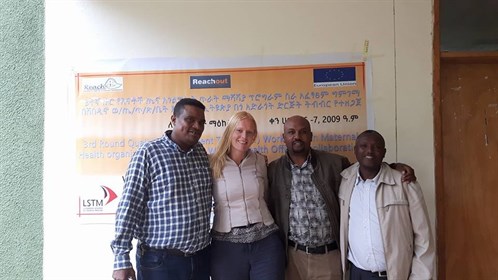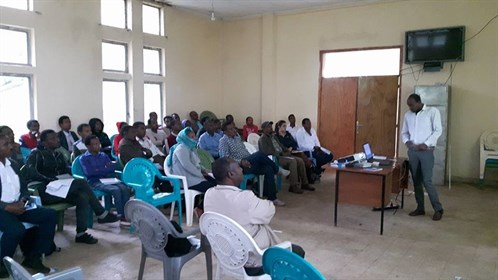
By Maryse Kok
Shebedino has a lot to offer. Especially the tastiest Ethiopian coffee, if you believe the locals. Indeed, the coffee ceremony in the Woreda Health Office not only provided a nice opportunity for a catch up between the REACHOUT team and the head of the office, Buriso Bulasho, but also brought us warmth and comfort on this cold and rainy day.
Although Shebedino is only 25km from Hawassa, where REACH Ethiopia – partner in the REACHOUT consortium – is located, the bad shape of the road made the trip to the final quality improvement evaluation workshop uncomfortable and time consuming. Arriving at the venue of the meeting, nine health centre level quality improvement teams were all ready to present their progress over the past year.
The quality improvement process
The health centre quality improvement teams comprise of five members: the head of the health centre (chair), the health management information system and maternal and child health coordinators, a health extension workers’ (HEWs’) supervisor and the Woreda Health Office focal person for that particular health centre.
As such, the diversity of workshop participants was wide and therefore I was impressed by the fact that all had the same understanding about what quality in primary health services entails. In line with the national healthcare quality strategy, quality care was defined as:
"Comprehensive care that is measurably safe, effective, patient-centered, and uniformly delivered in a timely way that is affordable to the Ethiopian population and appropriately utilizes resources and services efficiently"
The process of quality improvement, the plan-do-study-act (PDSA) cycle, was explained by several presenters. Earlier the quality improvement teams selected ten problems related to quality, of which they prioritized three. The problem was assessed, targets were set and activities were planned for, presented in a clear table including recourses needed, timing, evidence for completion of activities and who was responsible. This was the time for evaluation and refection.

Outcomes of the quality improvement interventions
Dulecha health centre (25km from the Woreda Health Office, four health posts, serving 38,214 population in a poor area), focused on antenatal care (ANC), postnatal care (PNC) and skilled birth attendance. HEWs with their health development armies (HDAs, women from each household assisting the HEW in health promotion) were tasked with early identification of pregnant women. In addition, health education was intensified through pregnant women fora and home visits by HEWs. Performance was evaluated every month; and the zonal level visited the quality improvement team once, to discuss the project. Attendance at the first antenatal visit increased from 63% to 73%, at the fourth from 53% to 68%. Challenges remained: skilled birth attendance (currently at 63%) is to be improved by reducing the drop-out of pregnant women from ANC4 to facility delivery. Furthermore, HDAs need further strengthening and HEW home visits still need to take place more often.
Dobe Toga health centre (catchment population of 34,089) brought about change in ANC1 and 4 (56% to 74%; 49% to 68%) by improving registration of pregnant women, improving feedback to HEWs from the side of the facility and continuous monitoring of pregnant women by HEWs and HDAs.
Abela Lida health centre (serving 28,391 people) reported on the grading of HDAs. A committee with different officials, including HEWs, perform quarterly assessments of households. Based on this, households receive a grade (A, B or C; with A being well performing and C being less well performing). Progress was made with more households deserving an A. This system made me wonder: the publicly announced grade can motivate, but also demotivate community members. The quality improvement team explained that very poor households are helped by the neighbourhood, for example by the provision of materials for pit latrines. Therefore, no one can have an “excuse” not to perform.
Over the past year, Telamo health centre (catchment population of 24,507) focused on improving the acceptance of long term family planning methods and increased service delivery to community members in need of special support. Identification of blind, deaf and elderly people was conducted together with the kebele chairmen, HDAs and HEWs. The poorest people were selected and provided with special support or health services via outreach. The presenter discussed a slide on “quality” versus “equity”, after which a good debate took place on how to achieve equity in all nine health centres that Shebedino has.
Mechanisms for success
Not sure if you have the same feeling from reading the summary above, but I was impressed with the progress made in the nine health centres. What were the mechanisms for success? Based on what transpired during the meetings, I identified the following:
- The Government of Ethiopia is currently focusing on quality improvement in health. In some health centres, the quality improvement team had more than four members (to six), as per recent training and guideline of the Ministry of Health. This reinforced the importance of the quality improvement team and its work, and provides an excellent opportunity for sustainability of the teams initiated by REACHOUT.
- The head of the Woreda Health Office, who attended the REACHOUT quality improvement workshop in Indonesia in 2015, has a strong interest and provides leadership in quality improvement through applying the PDSA cycle. With the decentralization of the health system, health centres receive a budget allocation from the government on an annual basis and on top of that, they have their own income from fees related to some of the services they provide. Therefore, after prioritizing quality problems, they are able to allocate budget for trainings or other activities. The joint enthusiasm for the quality improvement intervention even led to health posts making their priority lists and going through the same cycle.
- Many of the activities that were implemented by the health centres, following the action plan of the PDSA cycle, needed the work of HEWs and HDAs. Communication with HEWs was enhanced through HEW focal persons (lately re-named as kebele supporters): they are the linkage between health centres and health posts. They have monthly meetings with HEWs, in which performance is jointly assessed. HEWs are motivated by the possibility of upgrading, which is working well in Shebedino – again because of leadership at the level of the Woreda Health Office. HEWs do joint planning with HDAs. Although there is no reward system for HDAs, they get recognition in public meetings, because good performers are mentioned by name.
- Efforts from non-governmental organisations such as Reach Ethiopia never stand alone: the district has made progress as a result of the strong leadership at the Woreda Health Office, as well as (limited) efforts of other partners. To improve maternal health, maternity waiting homes were built at all health centres in 2014. In addition, a free ambulance has been running for two years, with 24/7 midwife attendance in the ambulance. I met the two midwives who are dedicated to making a difference for poor pregnant women living in hard to reach areas: it is not easy to be on the road at night. These are examples of interventions, launched by the Woreda Health Office, that contribute tremendously to the goal of REACHOUT in Shebedino: improving maternal health.
Positive stories need to be told
In health systems programming and research, there is a general complaint that positive stories outnumber the negative ones. We should learn more from things that did not work. I definitely agree with this. However, it is also important to write about the positive. Not only we can learn from the mechanisms of success in Shedebino for other districts in Ethiopia and beyond, but stressing the positive also keeps us going.
At the end of the day, heading back to Hawassa on the same bad road, the diversity of people walking, talking, selling and buying – but also struggling, exhausted because of hard working, in pain or feeling too cold – again stressed the idea that improving community health serves even a wider goal than health for all, it is a basis for sustainable economic development.
Recent news
- Universal Health Coverage: The economists’ perspective, 26 July 2017
- REACHOUT at the 10th European Congress on Tropical Medicine and International Health, 20 July 2017
- From colonial medicine to global health: sharing REACHOUT results with a Dutch audience, 18 June 2017

This project is funded by the European Union.
